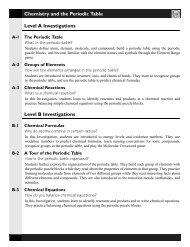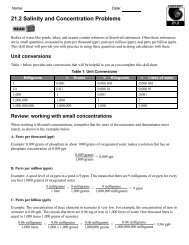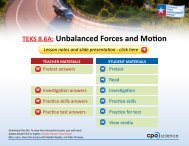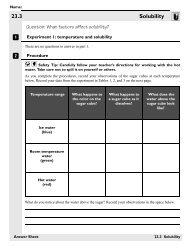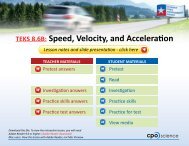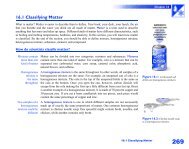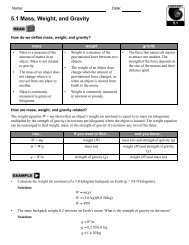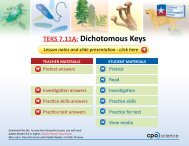You also want an ePaper? Increase the reach of your titles
YUMPU automatically turns print PDFs into web optimized ePapers that Google loves.
<strong>Water</strong> <strong>Systems</strong> Investigation <strong>23A</strong><strong>23A</strong> <strong>Water</strong> <strong>Systems</strong>How does running water shape rivers and the landscape?Running water on Earth's surface is apowerful force that shapes the landscape. Thepower of running water in a river is related tothe slope of the river, the shape of the river,and the volume of water flowing in the river. Ina river, water erodes sediment from thebottom and sides of the river and moves thesediment farther downstream. In thisinvestigation, you will model how runningwater moves different sized sediment particlesand shapes rivers.Materials• Stream table setup (includes stage, two buckets,table, removable tray, and grit)• Plastic Petri dish (for collecting grit at each level ofthe stream table)• Permanent marker• Beaker• Tweezers• Small hand shovel (optional)ASetting up1. Set up your stream table as shownin the picture at right. Make surethe table is set on the stage’ssecond rung. The bucket on thestage should have a spigot.2. Using your hands (or a shovel),smooth the sediment (grit) in yourstream table so that the bottomthird of the table is empty andclear of particles. The bottom thirdof the table represents the ocean.The sediment should slope fromthe “ocean” to just under the base of the tray.3. Use your hands to make a meandering stream channel in your sediment. Dig downonly halfway to the bottom of the sediment. Make sure your stream goes all the wayto the “empty ocean” in your stream table.4. Close the drain spigot at the end of the stream table. Place the bucket without thespigot under the drain spigot.5. Fill the upper bucket with water.6. Begin SLOWLY running water intothe top of the river channel. Watchthe river gradually fill with waterand the sediment particles movedownstream. Also note theformation of a delta at the mouth ofthe stream near your “ocean.”1
..Investigation<strong>23A</strong><strong>Water</strong> <strong>Systems</strong>B7. Stop the flow of water when your delta has grown into about half of your ocean, orwhen the water level in the ocean rises too close to the top of the stream table wall.8. Make sure the lower bucket is lined up with the drainage hole. Open the drain spigotand allow the water to drain from the table into the lower bucket. Observe thegeneral sizes of the particles remaining near the source of the river, the middle, andat the delta.9. Use a permanent marker to divide a petri dish into 6 equal sections,labeling them from 1 through 6.10. Using your tweezers, take small samples of the sediment from thefollowing locations and place them in the numbered sections of yourpetri dish. Use the last page of this investigation to find out what ariver delta looks like!• Section 1: The river source• Section 2: The end of the stream before the delta• Section 3: The middle of the delta• Section 4: The end of the delta• Section 5: The middle of the ocean bottom• Section 6: The far end of the ocean bottomStop and thinkDiagram 1: River systema. Make a drawing of your river channel, delta, and ocean. Label the following riverfeatures: meanders, river source, floodplain, delta, ocean.b. Number your diagram showing the location of each of your six sections. For example,label your river source “1.” Draw to scale the relative size of the sediment particles foundat each location.2
<strong>Water</strong> <strong>Systems</strong> Investigation <strong>23A</strong>c. How does the size of the particles change as you go from the river source to the far end ofthe ocean? Why do you think the sediment is sorted this way?d. Where was the speed of the water fastest? Where was it the slowest? How can you explainthis?CDoing the experiment1. Repeat steps 1 through 10 in the procedure. But this time, change the slope of thestream table so that it is steeper than your first trial.2. Repeat steps 1 through 10 in the procedure. This time, change the slope of the streamtable so that it is not as steep as the first trial.DThinking about what you observeda. How does increasing the slope of a river affect the rate of erosion by running water?b. How does decreasing the slope of a river affect the rate of erosion by running water?c. How do you think the width of the river channel affects the erosion of sediment in a river?d. Based on your knowledge of sedimentary rocks, where would you likely find samples ofconglomerate, sandstone, and shale in a river system?3
.Investigation<strong>23A</strong><strong>Water</strong> <strong>Systems</strong>EExploring on your own1. Use your stream table to model the formation of the following river features. Theimages on the next page will help you with your work.2. Your teacher will check off each feature as your team correctly models its formation.Your teacher can ask anyone in your lab group to model and/or describe how thefeature forms. Therefore, all members need to be prepared to answer. Your team willearn the most points toward your lab grade if you can demonstrate the knowledge onthe first try.Try 1 Try 2 Try 3v-shaped valley upstreammeandersdeltafloodplainalluvial fanoxbow lakewaterfall4
<strong>Water</strong> <strong>Systems</strong> Investigation <strong>23A</strong>5



